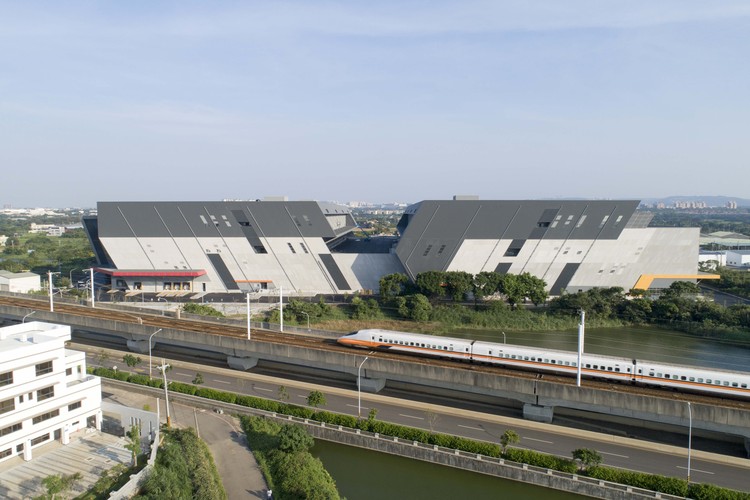Curitiba Cultural Centre HARDT Planejamento
2017-10-27 17:00
© Jefferson Carollo Filho
c.杰斐逊


架构师提供的文本描述。位于库里蒂巴的新的巴西创价国际文化中心(BSGI)成为该协会的重要建筑,该协会在巴西几个城市的192个国家和地区设有办事处。库里提巴BSGI从Jadim das Américas区的一座小建筑搬到库里蒂巴Bairro Alto 6 270平方米的新文化中心,面积超过2 000平方米。该活动的主题是举行盛大的庆祝活动,有典型的舞蹈、政府和负责该项目的建筑师发表演讲,巴西协会主席也出席了庆祝活动。
Text description provided by the architects. The new Brazil Soka Gakkai International (BSGI) Cultural Centre, located in Curitiba, became an important building for the association that has a presence in 192 countries and premises in several Brazilian cities. The Curitiba BSGI moved from a small building in the Jardim das Américas district to its new Cultural Centre of more than 2,000 sqm on a 6,270 sqm site in Bairro Alto, Curitiba. The occasion was marked by a grand celebration with typical dances, speeches by the administration and the architects responsible for the project, and was attended by the president of the Association in Brazil
Ground Floor Plan


定位单一单元的建筑占据角落地块的中心部分,提供慷慨的挫折,从边界,允许广泛的看法和与周围的小广场连接。选址战略允许最终通过位于停车场后面的一座附属建筑进行扩建,该大楼目前被停车场占用。行人通道是通过主要街道的中段,与建筑物的主要入口对齐。车辆通道位于“L”型停车场的末端,在行人通道附近有一个特殊的行政入口,与停车场相连。
POSITION The single-unit building occupies the central portion of the corner plot, offering generous setback from the boundaries and allowing extensive views and connection with small plazas around it. The siting strategy allows for eventual enlargement through an annex building at the back of the site, which is currently occupied by the car park. ACCESS Pedestrian access is through the central section of the main street, aligned with the main entrance to the building. Vehicle access is at the ends of the “L”-shaped car park, and there is a special administration entrance near the pedestrian access with a connection to the parking area.
© Jefferson Carollo Filho
c.杰斐逊


室外区域的景观处理是建立在建筑周围的5个广场空间的基础上的。每个广场都有一个圆形的形式,代表佛教文化和创价的一个重要因素。底层建筑具有视觉渗透性,底层循环与周围环境相连.主要通道是通过中间部分,通过一个金属遮阳篷,第二通道是这个的镜像,也是在建筑物的中心。从两个接入点寻求内部空间的易读性。东区设有500个座位的礼堂、技术室和服务通道.西区设有行政楼、厕所、客人接待室和一个小型礼堂,可容纳200人参加婚礼和其他规模较小的活动。西翼还包括垂直流经区,面向主立面。
LANDSCAPING Treatment of the outdoor areas was based on 5 plaza spaces located around the building. Each plaza has a circular format and represents an important element of Buddhist culture and Soka Gakkai. GROUND FLOOR The building is visually permeable, with ground-floor circulation connecting with the surroundings. The main access is through the central section, singled out by a metal awning, and secondary access is a mirror image of this, also in the center of the building. Easy readability of the internal spaces was sought from both access points. The eastern section includes a 500-seat auditorium, technical rooms, and service access. The western section contains the administrative wing, toilets, guest reception room and a small auditorium for weddings and other smaller-scale events, with capacity for 200 people. The western wing also contains the vertical circulation area facing the main facade.
© Jefferson Carollo Filho
c.杰斐逊


上层包括多用途客房,特别是用于祈祷和上课、办公室、音乐室以及通过悬挂在主大厅上方的人行道与礼堂阳台的连接。东区在礼堂后面有排练室。该建筑的生物气候特征包括改善其环境质量的几种解决方案。礼堂有一个噪音控制系统,由夹层屋顶和天花板之间的几层绝缘材料组成。屋顶通风口已在上层流通区域建立,侧窗允许对建筑物进行温度控制。在严寒的库里提巴冬天,百叶窗保持关闭,以保持建筑内的热量。在夏天,窗户被打开以释放旧的空气和热量,在建筑物的中心产生烟囱效应,空气通过入口门和侧窗被吸入。
UPPER FLOOR The upper floor contains multi-purpose rooms – particularly for prayer and classes, offices, music room and connection to the auditorium balcony via a footway suspended over the main hall. The eastern section contains rehearsal rooms to the rear of the auditorium. BIOCLIMATIC FEATURES The building includes several solutions for improving its environmental quality. The auditorium has a noise-control system formed of several layers of insulation material between the sandwich roof and the ceiling. Roof vents have been created in the upper-floor circulation areas, with side windows that allow temperature control of the building. In the harsh Curitiba winter, the louver windows remain closed to retain heat inside the building. In the summer the windows are opened to release the used air and heat, creating a chimney effect in the center of the building, with air being drawn in through the access doors and side windows.
© Jefferson Carollo Filho
c.杰斐逊


在建筑的两个部分之间创造了一个统一的体积,一个屋顶被设计成“拥抱”更多角度的观众席形状,以及行政和学术部分。一种增加音乐室和上层办公室可用面积的策略是将这些卷突出在主立面之外,从而为整个音量提供一种动态的感觉。大礼堂侧翼倾斜的墙壁允许保护和突出紧急出口,同时也创造了运动。玻璃、燃烧的花岗岩和白色山墙之间的对比也赋予了建筑更强的身份。
VOLUMES To create a unity between the two sections of the building a roof was designed to “embrace” the more angled shape of the auditorium together with the administrative and academic section. A strategy for increasing the usable area of the music room and offices on the upper floor involved projecting these volumes beyond the main facade, which thus offers a dynamic feel to the overall volume. The sloping walls of the auditorium side wings allow protection and highlight the emergency exits, while at the same time creating movement. The contrast between glass, flamed granite, and the white gables also gives the building stronger identity.
© Jefferson Carollo Filho
c.杰斐逊


























.jpg)









































Architects HARDT Planejamento
Location Rua Antônio Meirelles Sobrinho, 540 - Cajuru, Curitiba - PR, Brazil
Responsible Architect Marlos Hardt
Area 2140.0 m2
Project Year 2015
Photographs Jefferson Carollo Filho
Category Cultural Center
Manufacturers Loading...
























